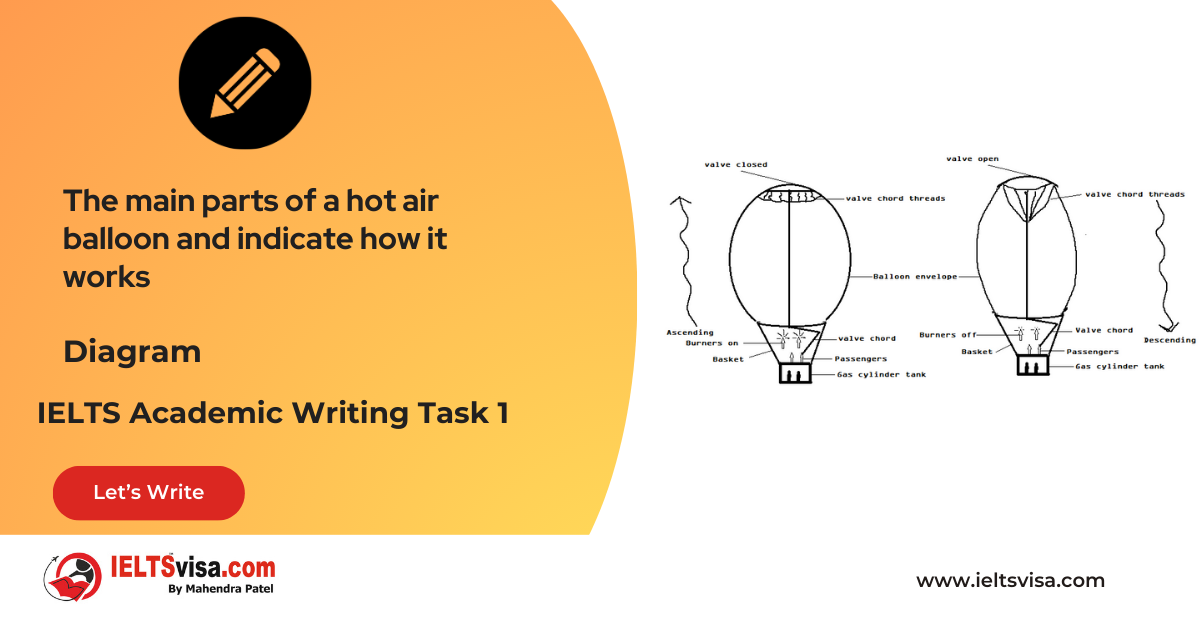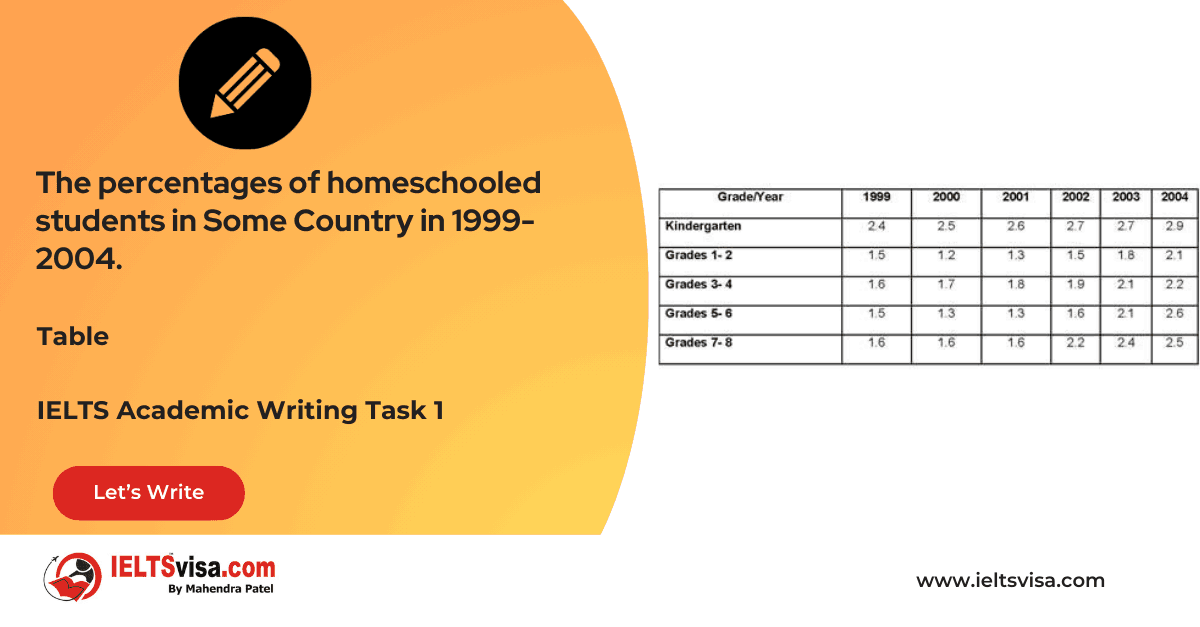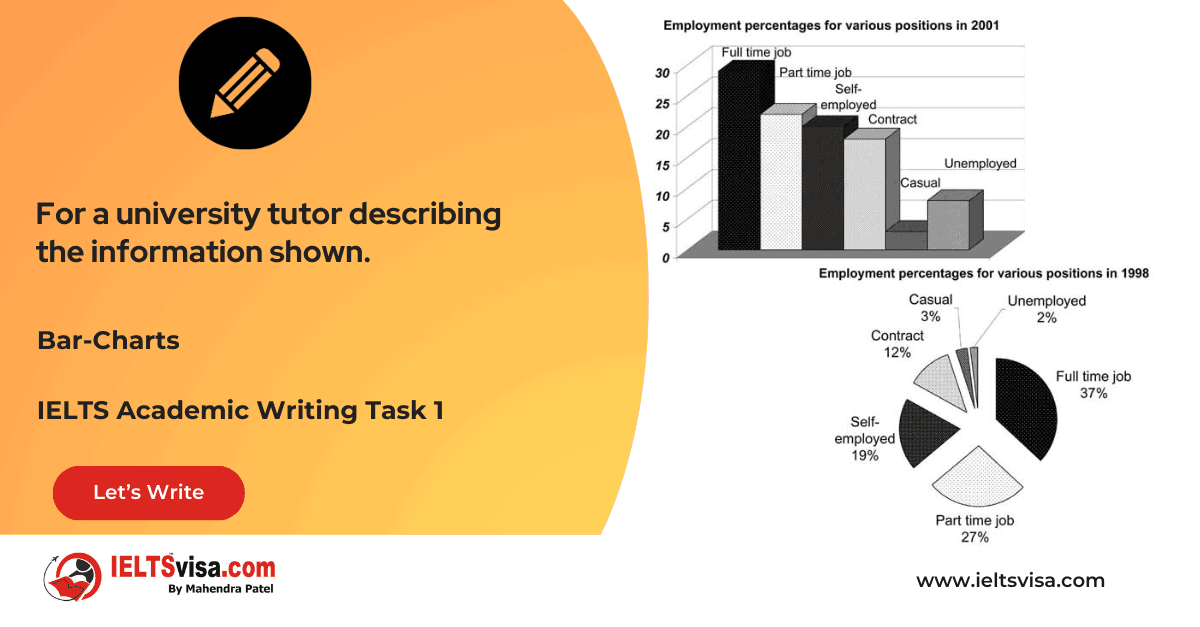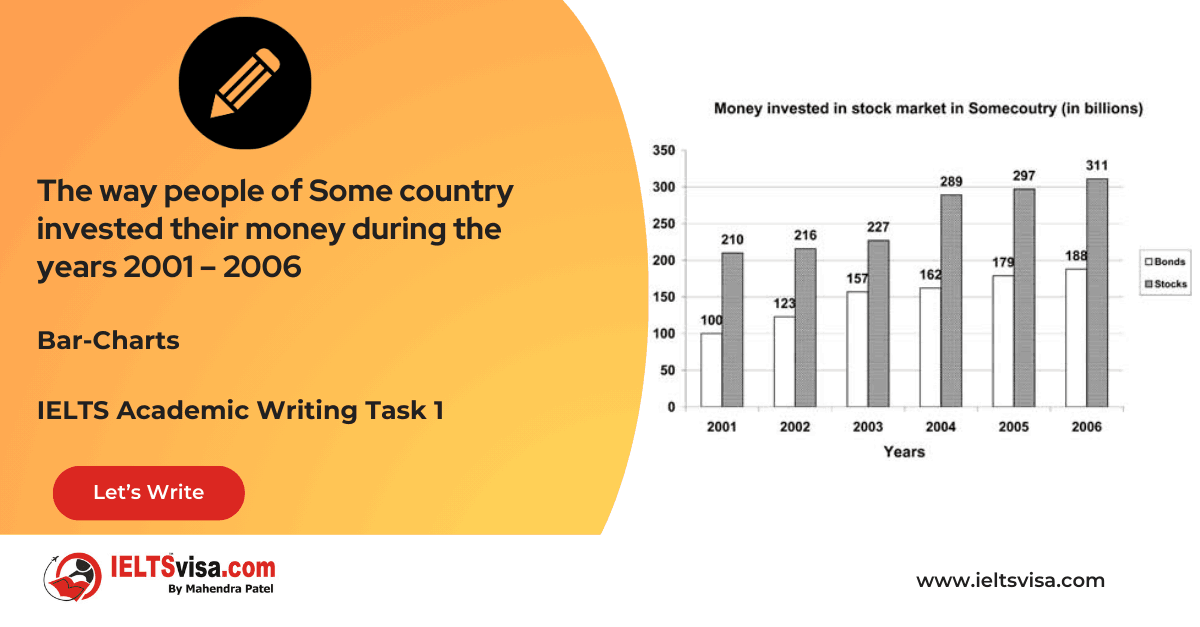The percentage of people who travelled by bus in the UK from 2009 to 2011
IELTS Academic Writing Task 1 - Tables
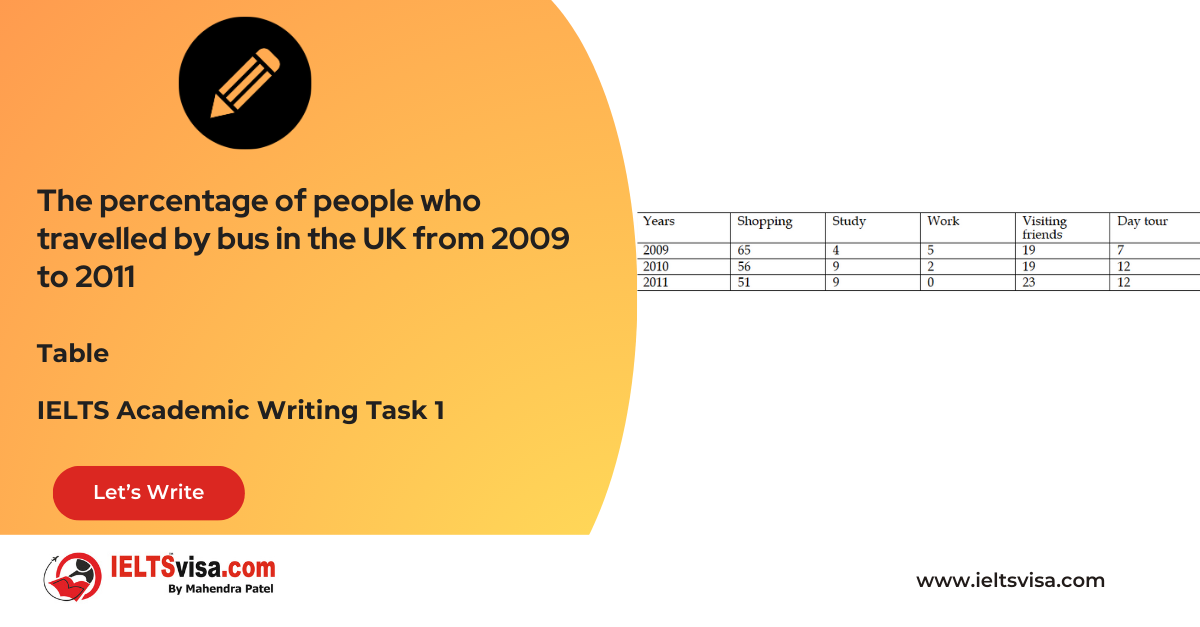
IELTS Writing Task 1 Question
The graph below shows the percentage of people who travelled by bus in the UK from 2009 to 2011. Summarise the information by selecting and reporting the main features and make comparisons where relevant.

Common Questions for the Table
1. Graph Type: Table
2. Title: Percentage of People Traveling by Bus for Various Purposes in the UK (2009–2011)
3. What are the units of measurement?: Percentage of people
4. Who: Bus users in the UK
5. When: 2009–2011
6. Where: United Kingdom
7. Topic: Trends in bus usage for different purposes
Comparison Showing and Trends Any change over time (such as an increase or a decrease) is a trend.
Comparison 1 : Shopping (Declining Trend)
- Details:
- 2009: Most popular purpose (65%).
- 2011: Dropped significantly to just over 50%.
Comparison 2 : Visiting Friends (Increasing Trend)
Details:
- 2009–2010: Around 20% of bus users.
- 2011: Slight increase to just under 25%.
Comparison 3 : Work Commute (Significant Decline)
-
Details:
- 2009: Around 5% used the bus for work.
-
- 2011: Usage declined drastically to almost negligible levels.
Sample Answer
The table illustrates the percentage of people in the UK who travelled by bus for different purposes from 2009 to 2011.
Overall, bus usage for shopping and work declined over the period, while the percentage of people using buses for visiting friends, study, and day tours increased slightly.
Shopping was the most common reason for bus travel in 2009, with 65% of users citing this purpose. However, this figure dropped significantly to just over 50% by 2011. Similarly, commuting to work by bus declined sharply, starting at 5% in 2009 and becoming nearly negligible by 2011.
Conversely, the proportion of people using buses to visit friends increased from about 20% in 2009 and 2010 to just under 25% in 2011. Bus usage for study and day tours followed similar trends, with day tours consistently attracting around 3% more users than study across all three years.
Top 27 Vocabularies
| Vocabulary | Type | Meaning | Synonyms | Examples |
|
Decline |
Verb/Noun |
A reduction or decrease |
Drop, Fall |
Bus usage for shopping showed a significant decline. |
|
Proportion |
Noun |
A part or share of a whole |
Percentage, Fraction |
The proportion of bus users visiting friends increased. |
|
Commuting |
Verb |
Traveling regularly between home and work |
Traveling, Journeying |
Commuting to work by bus dropped to negligible levels. |
|
Consistent |
Adjective |
Remaining steady over time |
Stable, Uniform |
Bus use for study remained consistent across the years. |
|
Negligible |
Adjective |
Very small or insignificant |
Minimal, Insufficient |
By 2011, bus usage for work was almost negligible. |
|
Illustrate |
Verb |
To explain or clarify using examples or visuals |
Depict, Show |
“The table illustrates bus usage for different purposes.” |
|
Usage |
Noun |
The act of using something |
Consumption, Utilization |
“Bus usage for shopping decreased over the years.” |
|
Purpose |
Noun |
The reason for doing something |
Intent, Goal |
“The purpose of most bus trips was shopping.” |
|
Sharp |
Adjective |
Sudden and significant |
Steep, Drastic |
“There was a sharp decline in bus usage for commuting.” |
|
Increase |
Verb/Noun |
A rise in amount or number |
Growth, Surge |
“Bus usage for day tours saw a slight increase.” |
|
Slightly |
Adverb |
To a small degree |
Marginally, Barely |
“The percentage of people using buses for study increased slightly.” |
|
Attract |
Verb |
To draw or pull interest |
Draw, Engage |
“Day tours consistently attracted more bus users than study.” |
|
Drop |
Verb/Noun |
A reduction in amount |
Decline, Fall |
“Bus usage for shopping dropped significantly over the years.” |
|
Significant |
Adjective |
Large enough to be noticeable |
Substantial, Noticeable |
“Shopping experienced a significant decrease in bus users.” |
|
Common |
Adjective |
Occurring frequently or widely shared |
Frequent, Prevalent |
“Shopping was the most common reason for bus travel in 2009.” |
|
Under |
Preposition |
Slightly less than |
Below, Just below |
“Bus usage for visiting friends rose to just under 25% in 2011.” |
|
Consistently |
Adverb |
Without change or interruption |
Steadily, Regularly |
“Day tours consistently had more users compared to study.” |
|
Trend |
Noun |
A general direction in which something changes |
Pattern, Movement |
“The trends indicate an increase in leisure-related bus travel.” |
|
Figure |
Noun |
A numerical value or statistic |
Number, Data |
“The figure for shopping dropped to just over 50% by 2011.” |
|
Decline |
Verb/Noun |
A decrease in number or quality |
Drop, Reduction |
“There was a noticeable decline in work-related bus usage.” |
|
Slight |
Adjective |
Small in degree |
Minor, Insignificant |
“The rise in bus usage for study was slight but steady.” |
|
Category |
Noun |
A group with shared characteristics |
Class, Group |
“Different categories of bus travel were analyzed in the table.” |
|
Evident |
Adjective |
Clear or noticeable |
Apparent, Obvious |
“A shift in travel purposes was evident over the years.” |
|
Leisure |
Noun |
Free time activities |
Recreation, Relaxation |
“Leisure activities like day tours saw a slight increase in bus usage.” |
|
Steady |
Adjective |
Regular and consistent |
Stable, Continuous |
“Bus usage for study showed a steady trend.” |
|
Minimal |
Adjective |
The smallest amount possible |
Negligible, Insignificant |
“Electricity consumption was minimal during the time.” |
|
Vary |
Verb |
To change or differ across different situations |
Fluctuate, Change |
“Reasons for bus travel varied across the years.” |

Our Books
Master IELTS Speaking Part 1
IELTS Writing Task 1 Book
IELTS Writing Task 2 Book
Writing Task 1 Question Types
Practice IELTS Other Modules
IELTS Listening
The IELTS Listening test assesses how well you can understand spoken English in various contexts. It lasts about 30 minutes and is divided into four sections with a total of 40 questions. The listening tasks become increasingly difficult as the test progresses.
IELTS Academic Reading
The IELTS Academic Reading section assesses your ability to understand and interpret a variety of texts in academic settings. It is designed to evaluate a range of reading skills, including skimming for gist, reading for main ideas, reading for detail, understanding inferences, and recognizing a writer's opinions and arguments.
IELTS Speaking
The IELTS Speaking test assesses your ability to communicate in English on everyday topics. It lasts 11-14 minutes and consists of three parts: introduction, cue card, and a discussion based on the cue card topic.
IELTS General Reading
IELTS General Reading tests your ability to understand and interpret various types of texts. Here are some key areas and types of content you can expect to encounter in the reading section, along with tips for effective preparation.
IELTS Academic Writing Task 1
In IELTS Academic Writing Task 1, you are presented with a visual representation of information, such as graphs, charts, tables, or diagrams, and you are required to summarize, compare, or explain the data in your own words.
IELTS General Writing Task 1
In IELTS General Writing Task 1, you are required to write a letter based on a given situation. The letter can be formal, semi-formal, or informal, depending on the prompt. Here’s a breakdown of the key components to include in your letter
IELTS Academic Writing Task 2
In IELTS Academic Writing Task 2, you are required to write an essay in response to a question or topic. Here’s a guide to help you understand the essential elements of this task
IELTS Exam Tips
To succeed in the IELTS exam, practice regularly, familiarize yourself with the test format, improve your vocabulary, develop time management skills, and take mock tests to build confidence.
Grammer for IELTS
Grammar is the foundation of effective communication in English. Understanding tense usage, subject-verb agreement, and sentence structure enhances clarity and coherence in writing and speaking.
Vocabulary for IELTS
Vocabulary plays a crucial role in the IELTS (International English Language Testing System) exam, especially in the Speaking and Writing sections. Here’s an overview of why vocabulary is important and how it impacts your performance
RECENT IELTS SAMPLES QUESTIONS AND ANSWERS
Task 1 – Diagram – A conference hall built in 1981 and planned for 2020
20:00 Start Pause Stop [df_adh_heading title_infix="IELTS Writing Task 1 Question" use_divider="on"...
Task 1 – Table – The percentages of homeschooled students in Some Country in 1999-2004.
20:00 Start Pause Stop [df_adh_heading title_infix="IELTS Writing Task 1 Question" use_divider="on"...
Task 1 – Table – For a university tutor describing the information shown.
20:00 Start Pause Stop [df_adh_heading title_infix="IELTS Writing Task 1 Question" use_divider="on"...
Task 1 – Bar-Charts – The way people of Some country invested their money during the years 2001 – 2006
20:00 Start Pause Stop [df_adh_heading title_infix="IELTS Writing Task 1 Question" use_divider="on"...
Task 1 – Diagram – Rainwater Harvesting and Conversion to Drinking Water in an Australian Town.
20:00 Start Pause Stop [df_adh_heading title_infix="IELTS Writing Task 1 Question" use_divider="on"...
Task 1 – Column graph – Percentage of Young People Enrolled in Universities in 2000 and 2007.
20:00 Start Pause Stop [df_adh_heading title_infix="IELTS Writing Task 1 Question" use_divider="on"...

